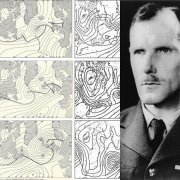
On the evening of the 4th June 1944, Group Captain James Stagg brought the latest weather forecast to Southwick House, where Eisenhower was meeting with his chiefs of staff to make one of the most important decisions in history.
They had already ruled out their preferred invasion date of the 5th June because of the weather. The 6th would be their last opportunity for at least two weeks, and their last, with the desired full moon, for a month. The German meteorologists were predicting two weeks of storms, which was why so many of their commanders along the front were either on vacation or attending the war games in Rennes, but Stagg’s information suggested the weather might not be that bad. Eisenhower decided to move, and the rest is, quite literally, history.
Eisenhower had two very clear choices that night: to launch the allied invasion of Europe, or to postpone it. Both were equally fraught with unknowns, uncertainties and great risks, but the one choice he didn’t have was to say “we don’t have enough information yet, let’s talk again next week”.
We all have occasions where we and our Boards need to make big decisions, although few of us will ever take ones of such consequence. All too often though, we seem to take that third choice, to ask for more information, to fumble and to postpone. All too easily we lose that momentum, forego the advantage, and miss the opportunity. When competition is intensifying and the pace of change is accelerating all around you, making no decision is the worst decision you can make. But it’s surprisingly easy to avoid. Here’s how.
The reason that “not deciding” wasn’t an option for Eisenhower, was because he had absolute clarity on four things; the same four things you can clarify to make faster, better calls on all of your big decisions. The keys to making timely decisions are:
- What you need to decide. Eisenhower’s decision was really clear: “Do we invade on the 6th or not?” But most decisions lack that clarity. A discussion about expanding overseas for instance might roll between which countries we could access, how we might gain entry, who we know we could work with. But the difference between could-we and should-we is profound. The allies had already decided whether to attack, where to attack and, through months of practice and planning, how to attack. Ike’s only decision was “when to attack”. How clear are you about the specific decisions you are trying to make?
- What you need to consider. Once you’re clear on the decision you’re making, you need to decide on what basis you will make it. Most big decisions get postponed because someone raises a new concern or a fresh consideration during the meeting, and the reason this happens is because there’s been no formal step beforehand to determine what criteria should drive the decision before the meeting begins. Eisenhower had very specific criteria, like tide times, visibility, wind speed and swell, weeks before the start of June. How clear are you about exactly what needs to be considered in order to make the decision?
- What information you need. Because Ike was crystal clear on the basis for the decision, the teams providing information were crystal clear on what to look for, and what to bring to that pivotal meeting at Southwick. No information is ever going to be perfect, entirely accurate and complete, least of all a weather forecast. But if you’re clear on the information you’ll need, the chances are, you’ll get enough to make the best decision at the time. How clearly do you articulate the information you need to enable you to make those big decisions?
- When you will decide. Timing is a balance of two things: how long it will take to get the information, and how long it will take to put the decision into action. Eisenhower’s staff could put theirs into action within 24 hours, so he waited as long as he could. Most of our decisions take far longer before the impact is felt by the customer, the client or the accountant, and the window of maximum opportunity is often closing before we even begin. The most effective decision processes set very tight timelines, and set them in stone. But the clearer you are about the decision you’ll make, the criteria you’ll consider and the precise information you’ll need, the easier that tight timeline will be, the better the decision you’ll make, and the more of the opportunity you’ll realise.
So the next time you find yourself in a meeting where a decision is postponed, take the lead. Before the meeting moves on, take five minutes to clarify, for everyone’s benefit, the precise nature of the decision you’re all trying to make, on what exact basis you want to make that decision and the specific information you’ll need in order to make it. And the next time you meet there will be neither the need, nor the excuse, to postpone it again. This is how you make timely decisions.
